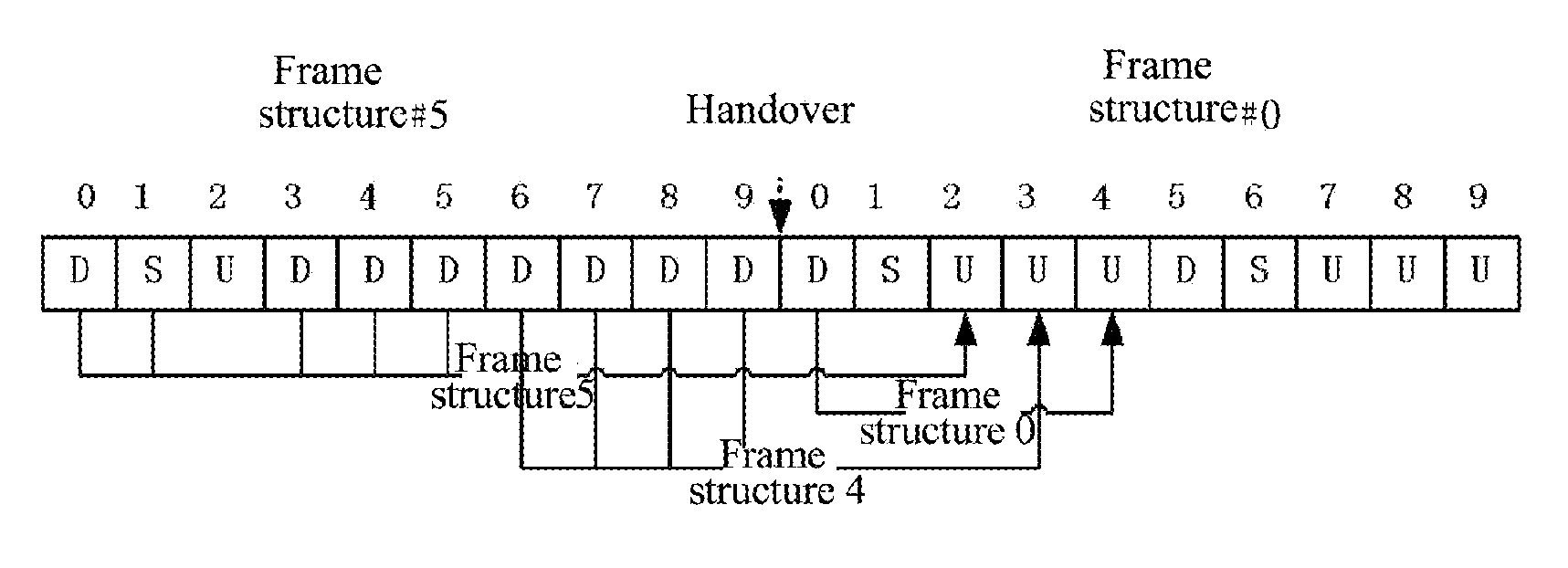Time division duplex adaptive frame structure retransmission method, network and terminal side device
a technology of adaptive frame structure and time division, applied in duplex signal operation, wireless communication, error prevention/detection by transmission repeat, etc., can solve the problem of not having a specific solution for setting the retransmission of downlink data frames, and achieve the effect of improving the retransmission performan
- Summary
- Abstract
- Description
- Claims
- Application Information
AI Technical Summary
Benefits of technology
Problems solved by technology
Method used
Image
Examples
embodiment one
[0054]The applicant proposes that in a frame structure configuration based on a minimum allocation unit of subframe, the uplink Acknowledgement / Negative Acknowledgement (A / N) resolution can be prioritized for frame structure allocation. The retransmission of the downlink data frame needs to be set according to the A / N resolution. The applicant also considers supporting two modes of A / N multiplexing and bundling in the existing standards. When a number of PDSCHs corresponding to a Physical Uplink Control Channel (PUCCH) is less than or equal to 4, both the multiplexing and bundling are supported. When the number of PDSCHs corresponding to a PUCCH is larger than 4, only the bundling is supported. Wherein, resources occupied by the multiplexing mode are more, but the multiplexing mode has a higher resolution, and can better improve the retransmission efficiency. On the basis of this, the applicant proposes a TDD adaptive frame structure retransmission method, which comprises:
[0055]in a...
embodiment two
[0066]The applicant also finds that the synchronous non-adaptive HARQ is used in the current standard, i.e., when an error occurs in the Physical Uplink Shared Channel (PUSCH) transmission, the retransmission thereof needs to be in a predefined subframe. In the adaptive frame structure configuration, such predefined frame structure will cause a conflict in timing. FIG. 2 illustrates a conflict scenario. In order to avoid the conflict, subframe 7 cannot be allocated to R10UE transmission. Similarly, almost all uplink subframes cannot be allocated to R10UE. A potential solution is that when a conflict occurs, the conflict subframe configuration is configured from a downlink subframe to an uplink subframe. However, there is the following risk in the method:
[0067]The gain of the adaptive frame structure is reduced. The probability of the uplink retransmission is generally larger than that of the downlink retransmission, and excessive retransmission will result in that many downlink subf...
embodiment three
[0090]The present embodiment provides a network side device, which at least comprises a first module and a second module.
[0091]The first module primarily searches for a frame structure whose RTT period of a PHICH and a PUSCH corresponding to an uplink subframe is 10 ms in seven already defined frame structures for the uplink subframe in a TDD adaptive frame transmission process;
[0092]the second module transmits PHICH data on a corresponding downlink subframe in the frame structure found by the first module, and receives retransmitted data on the corresponding uplink subframe in the found frame structure.
[0093]Wherein, the first module may newly define a frame structure whose RTT period is 10 ms or an integral multiple of 10 ms when a frame structure whose RTT period of a PHICH and a PUSCH corresponding to the uplink subframe is 10 ms is not found. It should be illustrated that the newly defined frame structure is one that does not conflict with various subframes in the seven already...
PUM
 Login to View More
Login to View More Abstract
Description
Claims
Application Information
 Login to View More
Login to View More - R&D
- Intellectual Property
- Life Sciences
- Materials
- Tech Scout
- Unparalleled Data Quality
- Higher Quality Content
- 60% Fewer Hallucinations
Browse by: Latest US Patents, China's latest patents, Technical Efficacy Thesaurus, Application Domain, Technology Topic, Popular Technical Reports.
© 2025 PatSnap. All rights reserved.Legal|Privacy policy|Modern Slavery Act Transparency Statement|Sitemap|About US| Contact US: help@patsnap.com


